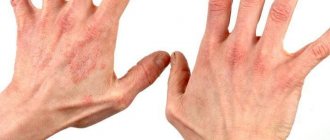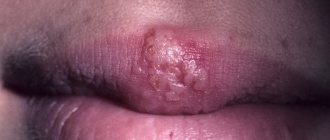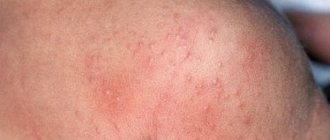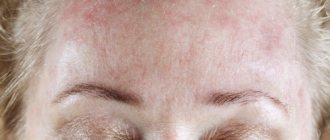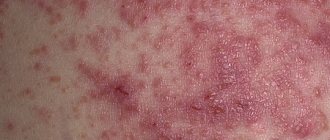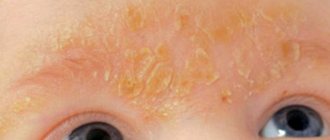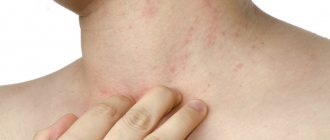Dermatitis in the groin area can develop in anyone.
Men and women are equally susceptible to it, regardless of age.
Dermatitis is an inflammation of the skin of the groin.
Without proper treatment, it can spread to the genitals over time.
All forms of groin dermatitis have common symptoms: severe itching and redness of the skin.
The main reasons for the development of inguinal dermatitis are as follows:
- Negligent attitude towards intimate hygiene;
- Increased sweating;
- Excess weight;
- Clothing and underwear made of synthetic materials;
- Clothes made from rough fabrics that are too tight;
- Allergic reactions, including to intimate hygiene products;
Dermatitis in the groin in women can develop due to low-quality pads.
Dermatitis in the groin in men develops when wearing tight underwear or clothing.
Important! Dermatitis in the groin can be caused by the use of antibiotics. Antibacterial drugs can only be used as prescribed by a doctor.
Types of dermatitis
Dermatitis, including inguinal dermatitis, is a disease that occurs for various reasons.
Its manifestations may also vary.
The most common types of dermatitis are:
- I. Seborrheic;
- II. Allergic;
- III. Contact;
- IV. Atopic.
Seborrheic dermatitis in the groin: symptoms, treatment
This dermatitis looks like red spots covered with scales.
The itching in this form of dermatitis is very pronounced.
Remember! Seborrheic dermatitis tends to spread, including to the genitals and anus.
This is a chronic disease, which means you should expect seasonal exacerbations.
It must be treated with corticosteroid drugs.
UV irradiation also shows effectiveness in the treatment of seborrheic dermatitis.
About dermatitis in the groin
for men and women, says lieutenant colonel of the medical service, doctor Sergei Gennadievich Lenkin
The content of this article has been checked and confirmed for compliance with medical standards by a dermatovenerologist, urologist, candidate of medical sciences.
Lenkin Sergei Gennadievich
| Name | Term | Price |
| Appointment with a dermatovenerologist | 900.00 rub. |
Allergic dermatitis in the groin: symptoms, treatment
Inguinal dermatitis due to allergies is characterized by itching in the genital area.
Externally, it appears as spots and rashes of pink-yellow and faint red colors.
In this case, women can use pads with aluminum acetate.
The basic principle of treating allergic dermatitis is identifying the allergen.
After this, its entry into the body should be excluded.
Drug therapy necessarily includes antihistamines.
Corticosteroid ointments may be used.
Contact dermatitis in the groin: symptoms, treatment
This type of dermatitis is associated with external exposure to the skin of an allergen or mechanical irritation.
Externally, redness and swelling of the area that was in contact with the irritant can be noted.
Bubbles with transparent contents may appear on the skin.
Treatment for contact dermatitis in the groin begins with stopping contact with the irritant or allergen.
Corticosteroid creams, lotions and ointments are used externally.
The doctor may prescribe, among other things, oral antihistamines.
Atopic dermatitis in the groin: symptoms, treatment
Atopic dermatitis appears as a red rash and severe itching.
The rash may develop into plaques or spots with severe swelling.
Atopic dermatitis in the groin can be a reaction to stress and nervous overload.
If you are prone to atopy, it is very important to prevent dry skin.
During exacerbations, you should refrain from scratching the affected areas.
Drug treatment includes antihistamines and corticosteroids.
In addition, SIT, an allergen-specific immune therapy, has recently gained popularity.
With this type of treatment, constantly increasing doses of the allergen are introduced into the body.
This leads to the body becoming resistant to its effects.
If you suspect dermatitis in the groin, contact the author of this article, a dermatovenerologist in Moscow with 15 years of experience.
No one is immune from a disease of such a delicate quality as a skin disorder in the groin area. The disease can affect anyone who does not maintain hygiene, does not eat properly, has a lot of bad habits, or has been exposed to a fungal infection through close contact with a sick person. We’ll talk about how inguinal dermatitis appears in people, what symptoms it shows and how to treat it, in this material. In addition, prevention methods are also important to help prevent the onset of the disease.
A little about the types of dermatitis
There is atopic dermatitis in the groin of the perineum - a skin lesion that causes severe inflammation.
It appears on the skin in the form of:
- red rash;
- severe itching;
- burning;
- increased body temperature;
- excessive sweating.
The rash often develops into growths that become very swollen and begin to rot. The causes of occurrence are:
- stressful situations;
- nervous breakdowns;
- reduced immunity;
- excessive stress on the body;
- sexual infections.
Under no circumstances should you scratch the sore spots. Urgent use of corticosteroids is necessary. Nowadays, immune therapy has become a very common treatment.
Thanks to it, the body produces additional bodies that contribute to the body’s resistance to the disease. Contact dermatitis in the groin can be caused directly by close contact of the allergen on the skin of the body.
Allergens include diapers, diapers, tight trousers, and uncomfortable and tight underwear. Contact causes mechanical damage, which causes:
It is necessary to get rid of the cause, monitor personal hygiene more carefully and use lotions and ointments.
Conclusion
Dermatitis in the groin area is a very insidious disease, despite the ease of treatment. At the first symptoms, you must immediately visit a doctor who will help determine the cause and prescribe the correct treatment.
This disease should not be neglected, as it can cause more serious consequences: purulent wounds, ulcers, blood poisoning, problems with urination, female diseases. Any disease is easier to prevent, so you should pay more attention to the cleanliness of your body, not gain excess weight and monitor the correct diet.
What is inguinal dermatitis in men?
Dermatitis in the intimate area of men is a skin disorder that causes severe itching, red spots, rashes and other formations that can even affect the genitals. Men get the disease for completely different reasons than when irritation appears on the skin of infants or in the groin of women. Before each treatment, doctors make a diagnosis and determine the main causes that should be addressed first.
Experts also say that if the symptoms go away in children, when you can simply treat the skin in the area of the folds, then with adults the situation may be different. Research shows that with age, the disease can only develop and become chronic. To get acquainted with the external manifestations of a disease such as inguinal dermatitis, you can study the photo presented here as an example.
FOR REFERENCE: Statistics from the World Health Organization show the latest results for 2020, that throughout the entire world, 1/3 of the population is such patients. Dermatitis is observed in women in the groin, in men, and even in 20% of children from all registered cases.
Dermatitis affecting the intimate area of patients can be either infectious or non-infectious. The first type of disease is contagious and it has the following varieties:
- Dermatophytosis. The appearance of rashes and other things is due to the presence of a fungal infection. It is transmitted through close contact with the underwear of an infected person, as well as through sexual contact.
- Erythrasmus. A disorder of the epidermis in the delicate area of the skin is manifested not only by fungus, but also by harmful bacteria.
- Candidiasis. A fungal disease that can affect the genitals both inside and outside. Its predominant localization begins with the mucous membranes of delicate tissues.
Symptoms and signs of inguinal dermatitis
It is not difficult to recognize the pathology on your own. It has characteristic symptoms:
- Foci of inflammation appear in the genital area, groin, and perineal area: the skin turns red, becomes swollen, and therefore swells slightly.
- The affected areas have a bright red, rough border.
- A papular and vesicular rash forms inside the affected area.
- Its formation causes severe burning and severe itching.
- The skin may peel and peel.
Different provoking factors cause the development of different types of inguinal dermatitis. Each has its own characteristic differences that can complement the clinical manifestations.
| Name | Stimulus | Additional signs |
| Candida | Yeast-like fungi | A nodular rash appears on the genitals, and a white discharge with a cheesy consistency comes out of the genitals |
| Seborrheic | Fungi Malassezia ovale | Red spots appear on the skin, inside of which the skin is covered with scales. When combed, they easily come away from the skin |
| Dermatophytic | Dermatophyte fungi | Severe irritation and white coating on the affected skin |
| Erythrasma | Bacteria | The appearance of bright red spots with papules is characteristic |
| Psoriatic | Unknown | Flaky spots of different locations |
In addition, each type of pathology can have three forms of expression. With a mild form of inguinal dermatitis, erythematous spots and a rash are formed, and itching appears. The moderate form of severity is characterized by the appearance of erosion of bulk elements. In severe cases, the formation of pustules and the formation of a moist scaly layer are observed.
Itching with dermatitis
What are the symptoms of groin dermatitis?
All symptoms have a pronounced character, so it is simply impossible not to notice them. Symptoms of inguinal dermatophytosis, photos of which are presented here, are recorded by the following set of indicators:
- severe itching in the groin;
- skin peels;
- pain in the affected areas;
- redness, red spots, swelling;
- the focus of the inflammatory process is framed by a clear red halo;
- the rash is red or blistering;
- pustular wounds and rashes.
As a result of the clear boundaries of the red smooth curved line along the edges of the spots, it feels as if red ink had been spilled over the skin. Such formations are also called “islands” or “waxy spots.” To identify the true causes and determine the diagnosis for such symptoms, the following specialists are involved:
- dermatologists;
- histologists;
- therapists;
- gynecologists or proctologists;
- venereologists;
- and even oncologists.
People come, of course, to a dermatologist for treatment, but the diagnosis of the disease can be carried out as part of an entire team of doctors. At the same time, blood tests are taken to check its biochemical composition, a biopsy of the affected skin and other tests that they deem necessary to prescribe to the patient.
What are the causes of groin dermatitis in men?
If in a woman dermatitis most often occurs due to a clear violation of the microflora of the mucous membranes inside the genital organs, or advanced thrush, then in men the lesion can also occur for other reasons. To verify the truth of the causes, you should study inguinal dermatitis in men in the photo, where the difference is clearly visible when the disease has a fungal form, where it is bacterial, where it is combined, and where the skin is completely inflamed due to constant excesses and frequent wearing of synthetic underwear.
Basically, medical experts identify the following series of reasons:
- Neglected state of the intimate area, lack of regular personal hygiene.
- Constant wet environment in the intimate area.
- Frequent use of wet underwear.
- Sweating and irritation.
- Concomitant or provoking diseases:
- diabetes;
- genitourinary canal disease;
- helminthiasis;
- attached scabies mite;
- diseases of the gastrointestinal tract (stomach and intestines);
- allergies to washing powder, detergents, etc.
- Excess body weight, which leads to folds of skin, inside of which there is constant moisture due to sweating.
- Bedsores that form during the postoperative period or for other reasons.
- Wearing synthetic underwear.
- Using dirty towels or someone else's underwear.
- Close contact with a person infected with an infectious disease.
In addition to these main 10 reasons, there are also other provocations. For example, due to long-term use of potent medications (antibiotics, for example), the immune system can be greatly weakened. This applies both to cases of inguinal dermatitis in women, photos and treatment of which are given in this article, and to diseases in men caused by an overabundance of medications. Therefore, it will be difficult for the body to work to eliminate this or that infection, bacteria, or fungus.
Inguinal dermatitis: what is it?
Inguinal dermatitis
is a certain type of allergic reaction in the body, which manifests itself in a rather delicate, intimate area, the perineum. Depending on the type of disease, there are papular formations, redness, spots and peeling of the skin.
The main reason is the presence of an irritant that constantly affects the groin area. In most cases, once the stimulus is removed, the reaction will go away on its own.
This disease has already been well studied by doctors; there is even a certain classification of inguinal dermatitis:
- candidiasis;
- seborrheic type;
- dermatophyte form;
- erythrasma;
- psoriatic form.
Each form has its own characteristics of manifestation and is subject to an individual treatment regimen.
Inguinal dermatitis in men: treatment and prevention
You should always contact a dermatologist for medical help when the presence of a set of symptoms similar to those given above in the text of this material has been identified. Even any patient can identify the first signals of a dangerous skin condition on his own. But you should also consult a doctor in order to exclude as effectively as possible the development of inguinal dermatophytosis in women or men. Let's consider two key areas of therapy - methods of orthodox medicine and methods of alternative (traditional) medicine.
How do doctors treat inguinal dermatitis in women and men?
Before talking about treatment methods, it is worth noting that it is extremely important for the patient to start caring for his intimate area properly. Maintaining personal hygiene can sometimes immediately remove a number of reasons. If there is already a question about eliminating dermatitis in the groin in women, how to treat it also in men, then the following main methods can be noted:
- Hygiene of affected areas. It is better to wash with tar or baby soap.
- Changing clothes made from synthetic fabrics to products made from more natural materials.
- Use gels, ointments and creams as prescribed by the doctor.
- Lotions with medications: chlorhexine, potassium permanganate, furatsilin and others that relieve inflammation.
- Topical sprays also improve the condition of sore skin.
For example, ointments such as Clotrimazole, Econazole and Ketoconazole are very effective in treating groin dermatitis in men. A good spray for the treatment of the intimate area is a complex treatment agent - Terbinafine. There are other means, there are a lot of them, so we have to note the most common options. Burst blisters and open wounds with severe severity of the disease should be washed and treated regularly, preventing further self-infection. Typically, wounds are treated with any disinfectant - fucarcin, brilliant green, hydrogen peroxide and others.
Etiology of the disease
Dermatitis in the groin in men most often occurs due to neglect of personal hygiene rules, due to excessive sweating or wearing tight synthetic underwear.
A humid environment is a favorable environment for the proliferation of pathogenic microflora. In such conditions, when the skin is damaged or the immune system is weakened, the preconditions are created for the development of a bacterial or fungal infection. Another common cause of the formation of the disease is prolonged mechanical impact on the skin (horse riding, driving a car). In women, it can be triggered by a violation of the vaginal microflora and improper treatment of thrush. Skin inflammation can act as a reaction to long-term use of antibiotics.
The constant presence of parasites in the body, dysfunction of the digestive tract, diseases of the pelvic organs, and long-term use of hormonal drugs can also provoke a characteristic reaction.
Diabetes mellitus causes disruption of all metabolic processes; as a result of this phenomenon, blood microcirculation deteriorates, the protective properties of the skin decrease, and therefore inflammatory reactions are born, which lead to the appearance of symptoms of inguinal dermatitis.
If you are overweight, deep folds form in the groin area. They are subject to friction and increased sweating. And these are also ideal conditions for the development of inguinal dermatitis.
A child's rash in the genital area may appear when wearing a wet diaper for a long time, due to improper care of the delicate skin.
Without eliminating the provoking factor, treatment of the symptoms of inguinal dermatitis becomes useless.
Treatment of inguinal dermatitis in men with folk remedies
The disease can also be treated with folk remedies, and doctors do not exclude them at all. The main thing is to consult your doctor in a timely manner about the use of this or that method. Photos of lotions or poultices, as well as their recipes, can be found on any website where alternative medicine specialists are ready to share their knowledge. To treat dermatitis in the intimate area in adults, you should listen to the opinions of experts in non-traditional treatment approaches, who recommend using the following approaches:
- Poultices with leaves of medicinal plants - sage, cherd, celandine, etc.
- Lotions with extracts and decoctions of herbs, which are also called applications.
- Compresses made from birch tar, which is also found in tar soap or shampoo, as well as egg white and castor oil.
A good soothing agent for the skin is a decoction of chamomile, oak bark, string and other plants that have anti-inflammatory properties. It is enough to wipe the sore skin with a soft cotton swab 2 times a day. If, with inguinal dermatitis in men, treatment and photos of which can be studied in more detail from medical experts, the patient refuses to buy ointments, then he can use vegetable or olive oil to soften the skin.
FOR REFERENCE: The most effective is still Indian castor oil, in which the content and concentration of ricin oil is an order of magnitude greater than in domestically produced pharmaceutical drugs.
What prevention should be done to prevent inguinal dermatitis in men?
To prevent the formation of an unpleasant sore in the groin in men, you just need to follow the basic standards of prevention and personal hygiene, which are as follows:
- Don't wear someone else's underwear or dry yourself with someone else's towel. You should always use your own things and objects.
- Do not have contact with a sick person through sexual relations.
- Avoid wearing synthetic underwear. The best options are products made from cotton fabrics.
- Linen must be disinfected constantly. Especially after completing a course of therapy.
- Maintain personal hygiene daily.
Treatment of atopic dermatitis
Atopic dermatitis has many different causes and symptoms. Therefore, treatment is prescribed individually in each individual case.
It is imperative to take into account the patient’s age, degree of neglect and the presence of concomitant diseases.
It is almost impossible to get rid of this disease using antihistamines; treatment must be carried out comprehensively and affect all organs involved.
The following phases are distinguished:
- if possible, completely eliminate the allergen from the patient’s life;
- minimize sensitivity to the allergen, contact with which cannot be avoided;
- relieve itching;
- cleanse the body;
- relieve inflammation;
- treatment of concomitant diseases;
- performing relapse prevention;
- treatment of complications.
By following all the recommendations, patients improve their condition for a long time. They can live, work and have fun in peace.
How to treat with folk remedies - recipes
Traditional medicine has proven itself well in the treatment of atopic dermatitis. If you systematically use generations of recipes, the disease is cured and does not bother you for a long time.
How to eliminate atopic dermatitis in adults - treatment with folk remedies:
1. Viburnum infusion helps a lot. To prepare it, you need to take 1 glass of fresh viburnum berries and pour 1 liter of boiling water over them. After the berries have been left to sit for 10 hours, the liquid must be filtered and taken 2 glasses a day for 2 weeks.
2. To treat the disease, use a decoction of: 2 tbsp of dried tricolor violet, 2 tbsp of string and three leaves of black currant. Mix everything and add 1 liter of water at room temperature. Next, boil everything and cook for 15 minutes. The decoction is filtered and consumed 2 tablespoons daily for 20 days.
3. Pour 3 bay leaves with a glass of boiling water and leave until cool. After which they drink half a glass daily for 10 days.
4. This tincture is used only by adults. To prepare it, take 10 g of dried tree peony, which is poured with 100 g of vodka. Also take 10 g of dried valerian root, also pour in 100 g of vodka and infuse both tinctures for 10 days in a cool, dark place. After which they are filtered and mixed. Take 10 days, 1 teaspoon three times a day after meals.
5. A glass of dried crushed pear leaves, pour half a liter of water, bring to a boil and boil for 5-7 minutes. Set the broth aside until it cools completely, then filter and use for topical use. A piece of cotton fabric is soaked in the liquid and applied for 2 hours, 2 times a day.
When using these recipes, it is imperative to take into account the individual characteristics of the body.
How to treat atopic dermatitis on the hands
Atopic dermatitis on the hands in adults is treated comprehensively. General strengthening, body cleansing and local treatment is prescribed. There are a variety of recipes that will help get rid of an exacerbation of the disease; you just need to choose the one that is best suited in this case.
Therapeutic baths are widely used for hands. To prepare them, brew chamomile, string or celandine in a ratio of 50 g of herb to 1 liter of boiling water. The infusion is diluted in 20 liters of water and hands are kept in it for 10-20 minutes. The water should not be hot. It must be peeled or boiled. It is better to use such a bath fresh every time.
To treat atopic dermatitis on the hands, medications are also used, which should be advised by a doctor. It is worth remembering that prolonged treatment of the disease with medication can lead to a number of negative consequences.
Treatment of atopic dermatitis on the face
The manifestation of the disease on the face is especially unpleasant, because it is very noticeable and, in addition to being physical, also has a strong cosmetic defect. They are trying to get rid of him as quickly as possible.
If you have such a disease, you should pay special attention to your diet and walk in the fresh air more often.
Decoctions of various herbs have proven themselves well.
Recipe:
1 tbsp of dry string herb per half glass of boiling water. Pour and leave until the solution turns dark brown. After this, you need to take gauze, dip it in the broth and make a compress, applying it to the affected area of skin on the face for 15 minutes. Repeat the procedure 4-5 times a day.
There are also a lot of folk recipes that are very effective and do not harm health. The most important thing in treating this disease is time. You shouldn’t let it go and aggravate the condition. It is better to deal with the problem in time, then success in treatment will come faster and more effectively.
Video about inguinal dermatitis in men
Scratching, redness and seborrhea are signs of genital seborrheic dermatitis in a man in the groin, it happens on the head of the penis or in the inguinal fold, we will tell you about the treatment and show a photo of the skin disease in the intimate area.
Skin diseases are very common, but when symptoms appear between the legs, the problem immediately becomes of a delicate nature. Many people mistakenly believe that any rash or ailment that affects the reproductive organs is associated with an STD. This is wrong. There are a number of pathologies that can manifest as an inflammatory process only due to an unbalanced diet, contact with an allergen, or due to the use of tobacco and alcohol. Such causes can be eliminated along with symptoms within a few days or weeks.
In another case, the problem is truly more serious and may be associated with infectious or viral diseases. A thorough medical examination and drug treatment based on the diagnosis is then required.
The doctor who deals with such delicate issues in men is a dermatologist. But sometimes patients are sent to a urologist, especially if itching and redness of the skin are accompanied by other symptoms that suggest the presence of diseases of the genitourinary system.
How to properly treat manifestations of inguinal dermatitis
To cure inguinal dermatitis, it is necessary to accurately determine the cause of its occurrence and eliminate it.
For these purposes, a number of laboratory tests are carried out:
- scraping from the affected areas and subsequent microscopy;
- bacteriological seeding in special cultural media;
- general blood analysis.
Deciphering the tests allows you to determine the fungal or bacterial nature of the disease, identify the pathogen and determine its sensitivity to modern antimycotic and antibacterial drugs. Based on the results, it is possible to create an effective drug therapy. Etiotropic treatment is carried out, the patient is prescribed antihistamines and sedatives. Creams and ointments are used to treat the skin to help relieve inflammation, relieve itching and burning, and stimulate the protective functions of the skin.
If the cause of the development of inguinal dermatitis is a fungal infection, the following are used to treat the disease:
- Systemic antimycotic agents (Difluzol, Fluconazole tablets).
- Creams and ointments with an antifungal effect (Ketonazole, Econazole, Terbinafine).
When the cause of the characteristic clinical picture is a bacterial infection, antibacterial ointment “Hydrocortisone” is used to treat the skin.
To prevent secondary infection, the affected areas are treated with solutions of Furacilin, Chlorhexine or potassium permanganate.
If dermatitis has led to the development of weeping, zinc ointment helps eliminate its symptoms.
Folk remedies
- Traditional medicine helps enhance the effect of drug therapy.
- A decoction of chamomile inflorescences and an infusion of oak bark relieve inflammation well. They are used for compresses and for hygiene procedures several times a day. The plant material is brewed with boiling water and then lightly boiled over a fire for five minutes.
- You can relieve pain and itching using lotions made from aloe juice or celandine. These products quickly relieve irritation and soothe the skin.
- You can reduce the degree of irritation with simple vegetable oil. Before use, it must be brought to a boil in a water bath, then cooled, and only then used for its intended purpose.
A woman carrying a child should not take antifungal and antibacterial drugs. Almost all of them have a pronounced teratogenic effect. Therefore, self-medication is unacceptable.
Therapeutic regimens are developed on a strictly individual basis. The main emphasis is on the use of traditional medicine. Sedatives and antihistamines of plant origin can be prescribed for oral administration; salicylic or eucalyptus ointment and sea buckthorn oil can be prescribed for skin treatment. A woman should adhere to a hypoallergenic diet throughout her pregnancy.
- scraping from the affected areas and subsequent microscopy,
- bacteriological seeding in special culture media,
- general blood analysis.
What is dermatitis in the intimate area
This is a skin disease that exclusively affects the external genital area. In men, it can be located on the head of the penis, on the pubis, and a common place is in the skin fold at the base of the legs. This location is explained by:
This disease is also common in women and children. It can occur on its own or be a manifestation of another illness, such as an infection or virus. The main symptoms of dermatitis are redness, itching, and the appearance of seborrhea, that is, peeling.
There are several scientific names for this pathology - dermatomycosis, athlete's foot, dermatophytosis. It affects many patients all over the planet, regardless of age, gender and race. The main reason is failure to comply with basic hygiene requirements or infection, which can occur during sexual contact or due to dirty hands.
Types of infectious dermatitis between the legs
This variety is considered dangerous because it is contagious and can also progress and gradually affect larger areas. Subtypes of infection:
- Dermatophytosis. The pathogen is a fungus that feeds on keratin - there is a lot of it on our skin. It can lead not only to a rash on the groin fold, but also gradually affect the mucous membrane, and then enter the bloodstream and affect the internal organs. This condition is called dermatomycosis.
- Erythrasma. The causative agent is a rod-shaped bacterium that is difficult to get rid of, so numerous control methods are used, including boiling clothes and bedding. Red, yellowish or brownish spots appear not only in the groin, but also on other skin folds, for example, in the armpits.
- Candidiasis. The pathogen is also a fungus, but unlike the first type, it is not the epithelium that is primarily affected, but the mucous membrane, and the inflammation is in the nature of rashes, that is, small spots; in men they are most often found on the penis. Another property is the opportunistic classification, meaning Candida is not dangerous as long as the host has a good healthy immune response.
Types of non-infectious inflammation of the skin in the groin area and inguinal fold in men
They are much easier to treat, since therapy mainly consists of two stages, you need:
- remove the irritant, such as detergent;
- moisturize and heal sores and rashes on the affected area.
- Seborrhea. This pathology is associated with a disorder of the sebaceous glands. It could happen for a physiological or psychological reason. The disease can manifest itself in the form of scattered spots or with a single focus. The hairy area on the pubis and between the buttocks often becomes inflamed.
- Psoriasis. The second name is scaly lichen. External symptoms include scales and bright spots. A very common autoimmune disease. In addition to immunity and stress, the reason is heredity. It is because of genetic predisposition that boys aged 10-15 years suffer.
- Mechanical damage - minor abrasions, scratches. They can become inflamed, as dust particles will get into microcracks and wounds. This can usually be easily resolved by wearing cotton underwear (or any non-synthetic one) and choosing a looser cut of trousers.
- Groin allergies in men. It can be caused by various reasons, the most common being powders and conditioners used to wash panties. An allergic reaction can also occur to artificial fabric. You should exclude the allergen and take an antihistamine as prescribed by an allergist.
- Intertrigo. The redness is light and pink. Usually they do not itch and do not cause discomfort. Often found in children, as well as in guys who play sports in unprepared clothing without holes for ventilation
Non-infectious rashes, of course, are much less dangerous, they are not contagious and in most cases are quickly treated. Therapy depends on the pathogen, the severity and neglect of development, as well as on what symptoms appear. For example, if papules are swollen, they are easier to heal than already open wounds - groin ulcers in men.
Degrees of dermatitis on the intimate organs
There are three stages in the development of the disease:
- Light form. Red spots appear and scales may form. Then the itching begins. During this period of therapy, it is enough to switch to cotton underwear, use healing ointments and make lotions filled with medicinal herbs.
- Average. The resulting bubbles become filled with a liquid substance and burst, allowing liquid to escape. The classic clinical picture suggests erosion. In this case, only creams will not help; you need to be tested for the causative agent of the infection and use medications against it, for example, an antifungal or antibacterial agent.
- Heavy. A purulent stage may begin. With it, all ulcers become inflamed, they produce pus, this is evidenced by bacterial foci - ulcers and sores in the groin in men. They may become covered with crusts, which peel off, and in their place the wound opens again. It should be treated only in a hospital setting, as self-medication can lead to serious consequences.
Treatment of the disease
Before treating groin dermatitis in men, you need to consult a doctor and determine the cause of the disease.
Only a qualified specialist can make an accurate diagnosis and select the optimal treatment regimen.
- Drug treatment
You can get rid of dermatitis with the help of special means, but only a doctor can prescribe them. If the disease is a symptom of another disease, it must first be treated. If there are pustules, it is necessary to use ointments. In case of fungal infection, the patient is prescribed medications that have antimycotic properties. The most popular medications:
- Clotrimazole.
- Terbinafine.
- Miconazole.
- Ketoconazole.
- Triderm.
- Econazole
These products are sold in the form of creams or ointments. Before application, the groin area should be rinsed well and then wiped dry. After this, the product is applied to problem areas and the area around. For maximum effectiveness of therapy, it is recommended to use talc and various powders. It is better to wear loose underwear to prevent contact with the skin and intense sweating. If there is no positive effect within ten days, you should inform your doctor. He will help you choose another medicine.
Baths and lotions have a good effect. They quickly relieve itching and eliminate inflammation, and have an antibacterial effect. For lotions, use a cotton swab dipped in a weak solution of potassium permanganate. The main thing is to hold it for no more than one minute so as not to get burned. You can also use Chlorhexidine and Furacilin. Terbinafine is very convenient - the spray kills bacteria, relieves itching and restores damaged areas.
In some cases, the doctor prescribes tablets:
- Fluconazole.
- Suprastin.
- Nystatin.
- Fenistil.
- Zyrtec.
Dermatitis in the groin in women and men cannot be treated with hormonal ointments, as there is a risk of the disease becoming chronic. In advanced stages of the disease, when treatment with external drugs does not have an effect, patients are prescribed cauterization using electric current. The procedure allows you to normalize the condition of the skin and stop the development of the disease.
- Folk remedies
Traditional medicine recipes are an additional means of therapy. Baths prepared from a decoction of medicinal herbs will help solve the problem of dermatitis. They effectively fight inflammation, relieve itching and kill bacteria. To prepare the mixture, the herb is brewed and kept on fire for about five minutes, then cooled.
To treat dermatitis, herbs such as celandine, chamomile, oak bark, string, and sage are used. A compress made from egg whites, castor oil and birch tar helps a lot. The mixture is applied overnight and removed in the morning. Problem areas can be treated with cold vegetable oil, but it should be boiled first. It is advisable for all patients to wear comfortable underwear made of cotton.
- Basic rules of therapy
When treating dermatitis, hygiene must be observed. All procedures are recommended to be carried out using fragrance-free soap. To prevent the recurrence of the disease, it is necessary to use an individual towel for the groin area.
Diet is equally important. Smoked and spicy foods, foods that can cause allergies: citrus fruits, nuts, honey should be excluded from the diet. This will help reduce irritation and the therapy will be much more effective.
Causes of dermatitis
For a woman, a characteristic rash usually indicates a progressive stage of thrush or other manifestations of an imbalance in the microflora of the intimate area. For a man, everything is not so simple. There are many factors, let’s consider some of them:
- Excess weight. This leads to the appearance of wide folds between the legs and the groin area, which can contribute to the appearance of sores and diaper rash in the groin area.
- Insufficient personal hygiene. You need to bathe once or twice a day, and it is recommended to use proven brands of shower gels that do not contain allergens and provide good protection against bacteria. You should also wash after sex and sports, and in any situation where you sweat a lot. You should definitely change your underwear every day.
- High humidity. If you are in conditions of high moisture content in the air (for example, a tropical climate) or simply have a high degree of sweating, then you create the most convenient conditions for the growth of fungus.
- Synthetic fabrics that are used for sewing underwear or bed linen.
- Prolonged inactivity, for example, after surgery or a serious illness when bed rest is required. Bedsores may form. They begin to swell and areas of redness form, turning into groin irritation.
- Some low-quality contraceptives are condoms with allergenic latex.
- Using other people's personal hygiene products, panties or towels can lead to infection or fungus.
- Sexual or other contact with a person who is already a carrier of an infectious disease, even if he does not have it. Some pathogens may not manifest themselves and are transmitted in a latent, that is, hidden form.
- Worm infestation. Helminths that are found in the gastrointestinal tract poison the blood with toxins, which leads to rashes on the outer layer of the dermis.
Dermatitis on the genitals (photo below) can cause a skin disease in the groin in men such as candidiasis - a fungal infection that leads to the formation of hard growths. It is usually transmitted from a woman; the disease is popularly known as thrush.
Causes of dermatitis in the groin
The cause of dermatitis in men in the groin area can be a variety of factors. In most cases, the presence of this skin disease depends on the man’s lifestyle and the characteristics of his body.
The following reasons for the development of dermatitis in the groin in representatives of the male half of the population are identified, namely:
- Increased sweating. A large number of sebaceous and sweat glands are concentrated in the intimate area. Their physiological purpose is to maintain a stable temperature in the groin so that the organs of the reproductive system work smoothly and there is no risk of diseases caused by overheating or hypothermia of the genitourinary system. In hot weather, sweating in this part of the body becomes more intense. Due to the fact that the intimate area is poorly ventilated, sweating products in the form of sebum may accumulate, which becomes a breeding ground for pathogenic microflora. As a result, the accumulation of bacteria provokes a response from the body in the form of itching, redness and the development of dermatitis. In addition to hot weather, increased sweating in the groin can also be caused by such ailments as poor circulation in the pelvic organs and tuberculosis.
- Allergy. Wearing underwear made from low-quality fabrics is one of the most common causes of allergic dermatitis. Especially if a man prefers synthetic fibers and clothing in which polyester predominates. As soon as the source of irritation is eliminated, the skin is immediately cleared of rash and redness, and metabolic processes in the epithelial tissues of the groin area are restored. To avoid allergic reactions in the future, you should wear underwear made of cotton fabric.
- Lack of hygiene. The groin area should be washed daily with warm water and soap. After water procedures, a man must wear clean underwear. Failure to comply with these simple hygiene standards threatens the accumulation of a large number of pathogenic bacteria, which can not only cause inguinal dermatitis, but also penetrate through the urethra into the organs of the genitourinary system, causing diseases such as cystitis, urethritis and chronic prostatitis.
- Excess weight. The formation of fat folds in the groin is one of the reasons for the development of dermatitis in people who are overweight. The disease most often manifests itself in the hot season, when a man's sweating increases. Friction of fat folds on wet skin provokes the development of inguinal dermatitis. In combination with a lack of hygiene, the disease manifests itself very acutely.
- Infections of the genitourinary system. The presence of chronic diseases of the reproductive system organs, caused by the constant presence of pathogenic bacteria in their tissues, causes inflammation of the surrounding epidermal tissues in the groin. In this case, treatment should begin not only with external treatment of the skin, but also with elimination of the immediate source of infection.
- Worm infestation. A large accumulation of parasites in the gastrointestinal tract can cause skin rashes throughout the body, including in the groin area. Dermatitis of a parasitic nature cannot be completely cured as long as there are a large number of helminths in the intestines that poison the blood with toxins and provoke an autoimmune reaction of the body in the form of a skin rash.
- Candidiasis in men. This is inguinal dermatitis of fungal etiology, when pathogenic fungi from the Candida family affect not only the mucous membrane of the genital organs directly, but also the skin of the intimate area. You can become infected with this type of eczema by visiting a public bath, swimming pool, shower, sauna, or as a result of unprotected sexual contact with a partner who is a carrier of a fungal infection.
First signs
Initially, you will feel discomfort, redness, and itching may appear. Also, the top layer of the epithelium will begin to die and peel off. In some cases, small sores that resemble blisters will form, but they contain pus rather than fluid. The affected area may bleed, become covered with crusts, and then gradually get rid of them.
In addition, the entire area becomes swollen, softer, and the halo of infection is clearly outlined in red. Pain is felt upon palpation, especially if the skin is damaged to the point of ulceration.
Symptoms of the disease
After the first signs appear at stage 1, if you do not take therapeutic measures in time and consult a doctor, more dangerous symptoms may appear:
- slight redness in the groin area in men (photo below) turns into a brightly saturated redness;
- if the cause is infectious, the temperature may rise and you may feel weak;
- in some diseases, areas of inflammation will begin to spread throughout the body;
- if the disease is urological in nature and the internal reproductive organs are affected, then complications are possible in the form of decreased libido, lack of erection and temporary infertility.
For problems with fertilization, doctors often prescribe Prostatilen AC - this is a drug with a unique effect on the quality and quantity of sperm, as well as a positive effect on the prostate.
Why does a rash appear in the groin area?
Among the causes that cause inguinal dermatitis
, you can note:
- excessive sweating;
- allergic reaction to synthetic underwear or intimate hygiene products;
- insufficient genital hygiene;
- excess weight, as a result of which folds of skin form in the groin area, and they are subject to friction and increased sweating;
- dysfunction of the gastrointestinal tract, as well as diseases of the pelvic organs;
- use of hormonal drugs;
- a bacterial or fungal infection that was acquired while visiting public toilets, saunas and baths.
Rash in a child in the groin area, photo
it is presented below, can only occur due to insufficient hygiene of the genital organs, as well as prolonged wearing of a diaper that rubs the skin.
Diagnostics
The doctor will visually examine the affected area, ask about the duration of symptoms, and then order clinical tests. You will need to donate blood, urine, feces (for helminths), as well as a genital smear to determine the infection. If the process is not inflammatory, but allergic, then allergy tests will be prescribed.
If more serious diseases are suspected, for example, dysfunction of certain internal organs, ultrasound, MRI and other studies will be performed. Based on the results, a diagnosis will be made and recommendations will be given.
Eczema in the groin area in men: how to quickly treat the disease at home
Home therapy is possible only at the first stage of the disease, if the cause is not infection, but incorrect underwear and external irritants. Then you should provide yourself with proper healthy nutrition, reduce physical activity, wear only cotton panties and make sure that there is no moisture in the groin fold and there is no arguing.
The use of dermatological creams will be relevant: Econazole, Triderm, Ketoconazole, Terbinafine, Clotrimazole, Miconazole. They relieve inflammation, eliminate peeling, soften the skin, preventing pain, and also disinfect, which is important when there is a risk of infection. You must have personal hygiene products - a towel, washcloth, and underwear.
Drug treatment
The drugs must be prescribed by a doctor. This could be a dermatologist or urologist. How to treat dermatitis in the groin:
- Antiseptics from a solution of chlorhexidine, potassium permanganate, furatsilin in liquid form.
- Botulinum toxin injections.
- Immunomodulators.
- Antibiotics – if the cause is bacterial.
- Antihistamines for allergies.
- Calming for stress and nervous overexcitation.
- Local ointments and creams.
Treatment
To cure dermatitis or reduce its symptoms on any part of the body (elbows, back, scalp in the hair and around the mouth), you must adhere to the following rules:
- Avoiding contact between the child and the irritant (gentle diet, control of household chemicals, natural clothing);
- External treatment is carried out with antiseptic dressings (medicinal ointment, special cream), folk remedies (herbal baths and rubbing infusions) help.
- Internal treatment consists of taking antiseptics and medications to reduce the allergic reaction.
- Medicines to improve intestinal function (bifidobacteria), calcium containing vitamin complexes, and a healthy diet (natural products without additives) help.
Means for the treatment of dermatitis (pharmaceuticals and medications, external ointment and cream) must be combined with diet and prevention of contact with the irritant.
Diet and nutrition
A hypoallergenic diet is necessarily included in the complex therapy of dermatitis, especially atypical ones, since the cause of diathesis is food products. Foods that cause allergies should be excluded from the diet of a child under 3 years of age and a nursing mother.
A child on a diet should not be given:
- Milk and fermented milk products;
- Bird eggs;
- Vegetables, fruits and red berries;
- Citrus;
- Fatty meats and fish;
- Smoked meats and pickles;
- Chocolate;
- Honey;
- Nuts.
When introducing complementary foods, give the baby a teaspoon a day of each new product, observing the reaction. Following a diet for dermatitis relieves the allergenic load on the baby’s body and helps prevent relapses.
Cream and ointment
To make dermatitis on a child’s skin go away faster, you need to smear the affected areas with antiseptic cream, medicinal ointments, and wipe the rash with disinfecting solutions and herbal infusions.
What creams can be applied:
- For weeping atopic eczema, steroid and antihistamine ointments will help;
- Seborrhea should be treated with antifungal creams;
- For diaper rash, dry the skin with solutions of potassium permanganate and apply moisturizing creams.
Bathe your baby daily in a decoction of chamomile and string, you can wash it with a weak solution of potassium permanganate 2-3 times a day to dry irritated skin.
Folk remedies
- Tincture of oak bark has antiseptic properties. For 100–150 g of wood chips, add a liter of water and cook over low heat until a dark liquid is obtained. Then leave for 3 hours and cool. You can wipe the areas with cotton wool or a bandage.
- You can brew chamomile in a similar way. You can buy a sachet or loose herb at the pharmacy.
- You can moisturize the affected area using vegetable oil heated in a water bath. Be sure to cool it before using.
Medicines and folk remedies
Preparations:
- Ketoconazole.
- Miconazole.
- Terbinafine.
- Clotrimazole.
- Econazole
- Triderm.
- Furacilin
- Chlorhexidine
- Terbinafine
- Fluconazole.
- Suprastin.
- Nystatin.
- Fenistil.
- Zyrtec.
Folk remedies:
- chamomile;
- celandine;
- birch tar;
- vegetable oil;
- sage;
- Oak bark;
- series;
- egg white;
- Castor oil.
For inguinal dermatitis in men and women, traditional methods are effective. They are used as an additional therapy to the main treatment.
It is recommended to make baths from a decoction of medicines. By their action they relieve inflammation and eliminate itching, and have antiseptic effects.
The decoction is prepared in this way: pour one tablespoon of dry herb into a glass of boiling water, simmer for about five minutes and cool. You can use the decoction for baths and compresses.
For inguinal dermatitis, herbs are used:
- chamomile;
- series;
- Oak bark;
- sage;
- celandine.
It is recommended to make a compress from birch tar, egg white and castor oil. The mixture is applied in the evening and removed in the morning. You can apply boiled cold vegetable oil to the affected area twice a day. It is advisable to wear loose and cotton underwear.
After the child’s condition improves, it is not recommended for adults to interrupt treatment. You need to complete the course of therapy as prescribed by the doctor. This is the only way to avoid relapse of dermatitis.
Prevention
- To avoid such intimate problems, you need to:
- Shower daily and change fresh underwear.
- Wear panties made from natural fabrics.
- Do not use other people's towels.
- Do not have sexual intercourse with unknown partners.
- Watch your diet and give up bad habits.
In the article we told you how and how to treat inguinal dermatitis. Consult a doctor promptly if you notice a rash or inflammation. Below is a video on the topic of the article.

